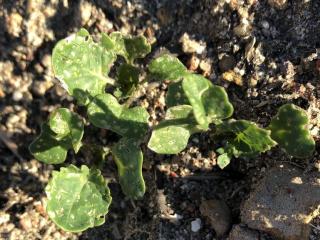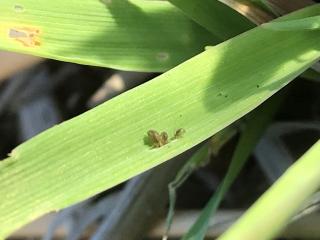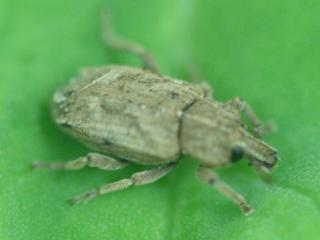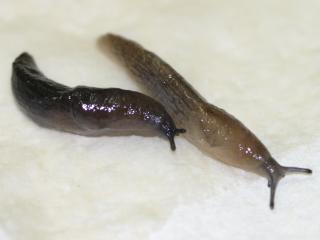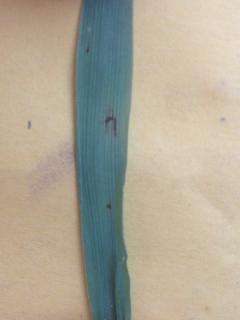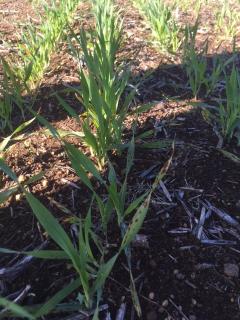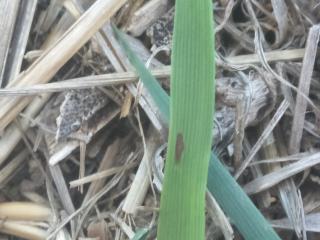Lucerne flea activity update
- Doodlakine to Meckering
- Corrigin
- Cadoux to Muntadgin
- York to Pingelly
Dan Taylor (DKT Rural Agencies) reports that lucerne flea are out in force and causing damage in canola from Doodlakine to Meckering.
Michael Macpherson (Imtrade) says that lucerne flea are ‘hammering’ cotyledon stage canola and barley volunteers east of Corrigin. They are also present in medic pastures.
David Stead (Anasazi Agronomy) reports that lucerne flea are active in lupins, and some canola, from Cadoux to Muntadgin and York to Pingelly on relevant soil types.
With many crops still germinating or very young, growers are again reminded to inspect crops for mites and lucerne flea. Whilst crop establishment pests such as aphids and caterpillars require a living host (e.g. green bridge) to survive and carry over onto a new crop, some pests such as mites and lucerne flea hatch from over-summering eggs when the conditions are right regardless of the green bridge. Similar to last year, we have experienced a late break to the season which has caused a late hatching of lucerne flea. Hatchings were triggered by heavy rains earlier in the month. This means that paddocks which received an insecticide weeks ago may be susceptible to damage by lucerne flea. Last year some crops (especially cereal crops) were left unmonitored after sowing and lucerne flea caused high amounts of damage in a short period of time, killing some plants and stunting surviving plant growth.
For more information on lucerne flea, refer to the 2019 PestFax Issue 5 article Be aware of mites and lucerne flea as crops germinate.
For insecticide information refer to DPIRD’s 2019 Autumn/Winter Insecticide Guide.
For more information about diagnosing and managing lucerne flea, refer to DPIRD's Diagnosing lucerne flea page.
For more information on invertebrates in crops and pastures contact Dustin Severtson, Development Officer, Northam on +61 (0)8 9690 2160 or Svetlana Micic, Research Officer, Albany on +61 (0)8 9892 8591.
Vegetable weevils and slugs are damaging canola
Vegetable weevils
- Geraldton
- Belka
Grant Thomson (Crop Circle Consulting) reports that vegetable weevils have damaged canola near Geraldton.
David Stead (Anasazi Agronomy) has found a localised but massive infestation of vegetable weevils in canola near Belka. The paddock was sprayed with the insecticide Pryrinex Super®.
The vegetable weevil (Listroderes sp.) prefers broadleaved plants, especially capeweed.
Vegetable weevils are about 10mm long with two short white stripes at an angle on each side of its abdomen. They are often camouflaged amongst stubble and trash and tend to hide during the day. Sections of cotyledons or leaves missing (often in patches) are a good indication of weevils or small caterpillars.
They may be confused with two other common weevil pests of crops and pastures: the spotted vegetable weevil (or desiantha weevil; 5mm) and the small lucerne weevil (10mm). Importantly, the vegetable weevil requires higher rates of insecticides than most pests of canola. For more information see DPIRD’s 2019 Autumn Winter Insecticide Guide.
For more information on weevils visit DPIRD's Diagnosing weevils in canola page.
For more information on weevils contact Dusty Severtson, Development Officer, South Perth on +61 (0)8 9690 2160.
Slugs
- Wannamal
Dave Nicholson (DPIRD) reports that slugs have been damaging a canola seedling crop near Wannamal and will require control.
There are two slug species that are pests of broadacre crops the black keeled slug and the reticulated slug. Other slug species can be present in the paddock. For more information see DPIRD’s Diagnosing slugs in crops page.
Baiting now when crops have emerged will have reduced effectiveness as there is a lot of green material that provides an alternative food source for the slugs. Even bait coverage increases the likelihood of slugs or snails encountering the bait and feeding on the bait. Trials suggest 30 baits per square metre give good control.
Growers need to be proactive now to determine what they will need to do next year. Now is the time to check paddocks that you will seed with canola next year. Soil type doesn’t matter - slugs can survive hot, dry summers in lighter soils if there is enough moisture in the soil profile.
In 2020 check paddocks that had slugs this season before seeding. Budget to apply bait more than once, but be aware that spreaders calibrated for fertiliser spreading may not be spreading the baits as far as you think. If you are patch baiting only where you are expecting slugs make sure you bait sufficient area around the patches to cover movement of slugs from these areas.
For information on snails and slugs and their management see:
- DPIRD’s Identification and control of pest slugs and snails for broadacre crops in Western Australia page
- GRDC’s Slug identification and management factsheet
For further information on slugs contact Svetlana Micic, Research Officer, Albany on +61 (0)8 9892 8591.
Net blotches found in barley crop and volunteers
- Wongan Hills
- Corrigin
- Frankland River
- Kojaneerup
Plant pathologist Jason Bradley (DPIRD) has found net-type net blotch (NTNB) in Baudin barley regrowth near Wongan Hills.
Michael Macpherson (Imtrade) reports finding spot-type net blotch (STNB) in volunteer barley east of Corrigin.
Laura Archer (Elders) reports finding STNB in Planet barley seedlings that were sown mid-May at Frankland River. The paddock was in canola last year and Granger barley the year before. The crop sown with Hombre Ultra® which does not protect against net blotches.
Plant pathologist Kithsiri Jayasena (DPIRD) recently found STNB in Rosalind barley regrowth at Kojaneerup.
Net blotches being found on barley volunteers or regrowth is a good indicator that conditions are ripe for net blotches and that barley on barley seedlings are at risk of infection.
Both STNB and NTNB are stubble borne diseases, the fungus is carried from season to season on infested stubble. The closer new crops are sown to stubble, the greater the risk of infection occurring at early growth stages.
STNB lesions develop as small circular or oval dark brown spots with yellow edges.
Infections can occur following around six hours of leaf wetness at temperatures between 10-25°C. Primary inoculum comes from airborne spores, which are produced on stubbles from previous crops. Risk of infection in seedling to tillering growth stages is greatest in barley regrowth and continuous barley which are exposed to infected barley stubble.
STNB occurs state-wide but is most damaging in south coastal and neighboring medium to high rainfall regions where it can have severe yield and quality effects.
NTNB lesions appear on leaves as thin brown streaks or blotches that may enlarge up to several centimetres in length. Darker longitudinal and horizontal lines sometimes develop in the lesions, creating a net like appearance.
NTNB infection and spread is favoured by wet conditions and it is most evident following periods of rainfall. It will cause the greatest yield loss in paddocks that are re-sown to barley without a break-crop as the fungus is stubble borne, carried from season to season on infected barley stubbles. Spores produced on stubble are spread by wind to initiate infections in new barley crops. Seed infection is rare and is considered of minor importance in spreading disease.
Barley varieties that are susceptible to STNB or NTNB that have not been treated with a registered seed dressing against net blotches (ie Systiva® or Uniform®) and are sown into in a high risk situation (barley on barley) are particularly vulnerable. To see which barley varieties are susceptible to STNB and NTNB refer to DPIRD’s 2019 barley variety sowing guide for Western Australia.
Growers with significantly higher levels of NTNB disease infection are also encouraged to collect plant samples before they are sprayed and send them to the department to aid identification and assist research to learn more about this new pathotype. Growers sending samples with suspected NTNB to the department can contact DPIRD technical officer Simon Rogers on +61 (0)8 9368 3445.
Managing net blotches and being mindful of resistance
Applying a fungicide spray is necessary in medium to high rainfall regions where disease threatens crops with high yield and quality expectations, particularly if the barley crop has been sown into or adjacent to last year’s barley stubble.
Application of a registered foliar fungicide prior to stem extension (for example, tillering) can reduce disease levels but may still require a follow-up fungicide later in the season. In low rainfall areas fungicide applications are most likely to result in a yield response to STNB when the disease pressure is high and there is reasonable spring rainfall or stored soil moisture.
The choice of a single-spray or two-spray strategy depends on the environment in which the crop is growing. In high rainfall environments it may be necessary to apply two sprays, such as at early stem elongation stage with a follow-up spray three to four weeks later.
While in medium rainfall regions, consider one well timed spray between late stem elongation and early flag leaf emergence (Z33 - 39) to protect leaf 2 (flag-1). Under high disease pressure, best results may be obtained by using the maximum recommended rates.
Details on which foliar fungicide active ingredients are registered for STNB and NTNB can be found at DPIRD's Registered foliar fungicides for cereals in Western Australia.
Fungicide resistance to DeMethylation Inhibitor (DMI) fungicides (Group 3 or DMI), such as tebuconazole and propiconazole, has been identified in samples of STNB and NTNB taken from WA’s lower Great Southern and Esperance regions. For more information see the Centre for Crop and Disease Management's (CCDM) Spot form of net blotch debuts on the fungicide resistance list article.
If you suspect fungicide resistance in your paddock please contact the CCDM's fungicide resistance team at frg@curtin.edu.au or phone +61 (0)8 9266 4818.
To prevent further development of fungicide resistance it is recommended that growers; rotate fungicide modes of action, avoid using the same mode of action twice per season, use fungicide mixtures with more than one mode of action and use appropriate label rates. It is also recommended that tebuconazole is not used as a stand-alone product, in barley for any disease.
For further information on symptoms and management of blotches see DPIRD’s Managing spot type net blotch in continuous barley and Managing net-type net blotch of barley in Western Australia pages.
For more information contact Kithsiri Jayasena, Plant Pathologist, Albany on +61 (0)8 9892 8477, Geoff Thomas, Plant Pathologist, South Perth on +61 (0)8 9368 3262, Andrea Hills, Plant Pathologist, Esperance on +61 (0)8 9083 1144 or Ciara Beard, Plant Pathologist, Geraldton on +61 (0)8 9956 8504.
Septoria avenae blotch in oats
- Highbury
Research officer Kylie Chambers (DPIRD) has reported finding very-low levels of septoria avenae blotch in a DPIRD oat trial near Highbury. The disease was found on all varieties in the trial; Carrolup, Bannister, Brusher, Williams, Korabup, Mulgara, Wintaroo and Yallara. The oats had been sown into oat stubble and were at two leaf stage.
Septoria avenae blotch symptoms can appear as brown to purple spots on leaves developing into light and dark brown blotches, with dark brown centres. They are restricted and distinct at first but may enlarge to cover most of the leaf.
Infected stubble is the main source of carryover infection from one season to another. The sexual stage of the fungus Phaeosphaeria avenaria occurs on infected stubble and produces ascospores which are spread moderate distances by wind and are the source of infection in new crops. In consecutive oat rotations where stubble is not destroyed ascospores land on the new crop in large quantities resulting in the development of earlier and more severe outbreaks than in rotation crops.
Septoria avenae blotch can be minimised by avoiding continuous oat cropping but under high disease pressure, such as continuous oat crops, and in favourable environments foliar fungicides can be utilised to reduce disease severity and reduce potential disease losses.
Trials carried out in 2014 by Ashton Gray (formerly ConsultAg) showed that application of registered fungicide as a single spray at flag leaf or multiple sprays at stem extension and again at flag leaf could result in significant yield increase in the susceptible variety Bannister sown onto oat stubble. For further reading refer to the Best practice fungicide management for Bannister oats in the medium and high rainfall zones of Western Australia Crop Updates paper.
For a list of registered fungicides to use as foliar sprays visit DPIRD’s Registered foliar fungicides for cereals in Western Australia page.
More information visit DPIRD’s Diagnosing septoria avenae blotch in oats and Oats: leaf diseases pages.
For more information contact Geoff Thomas, Plant Pathologist, South Perth on +61 (0)8 9368 3262 or Kylie Chambers, Plant Pathologist, Northam on +61 (0)8 9690 2151.

